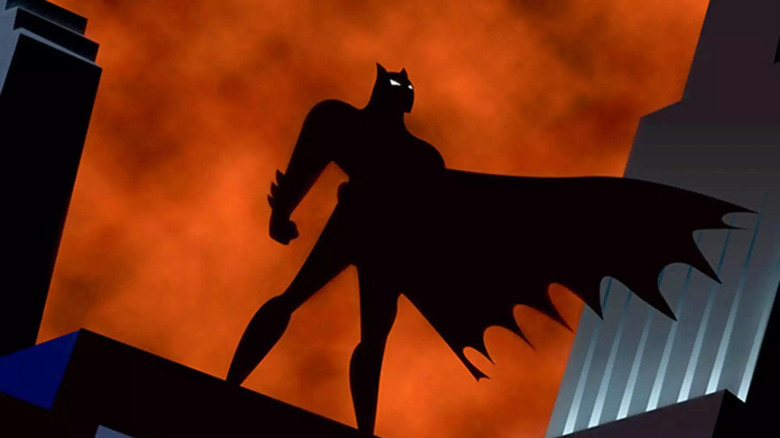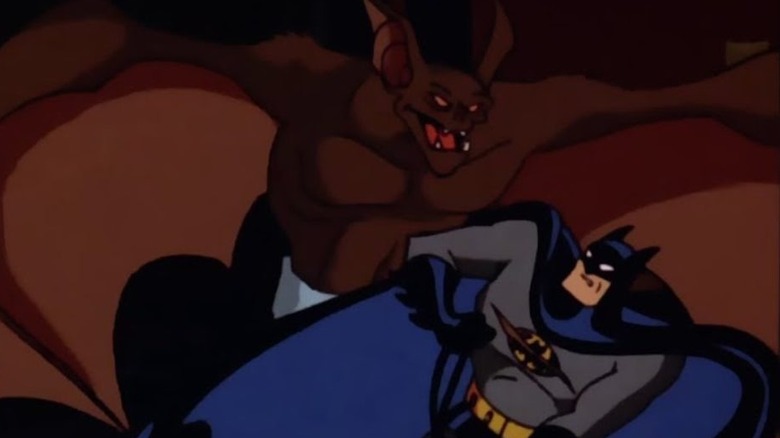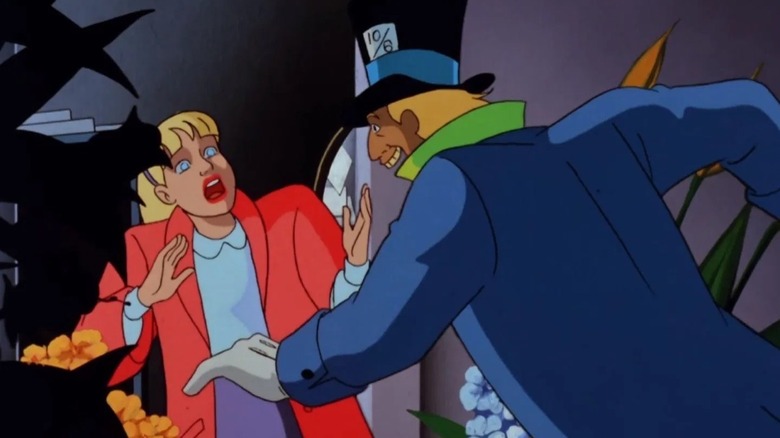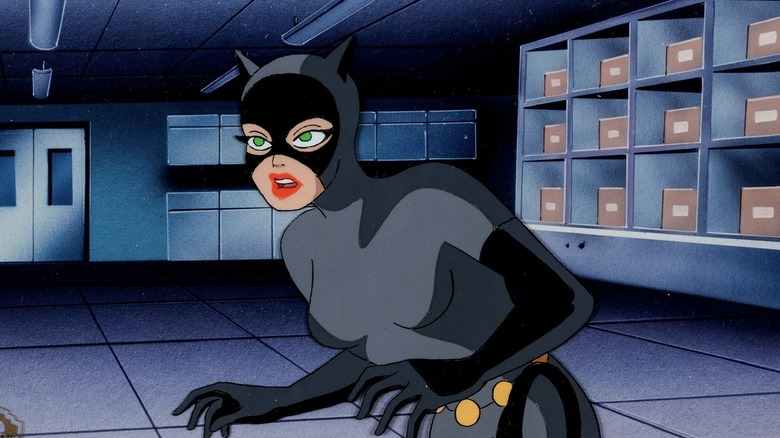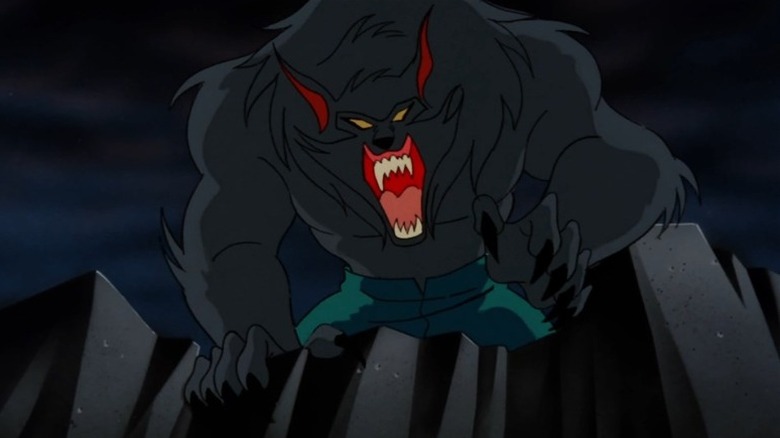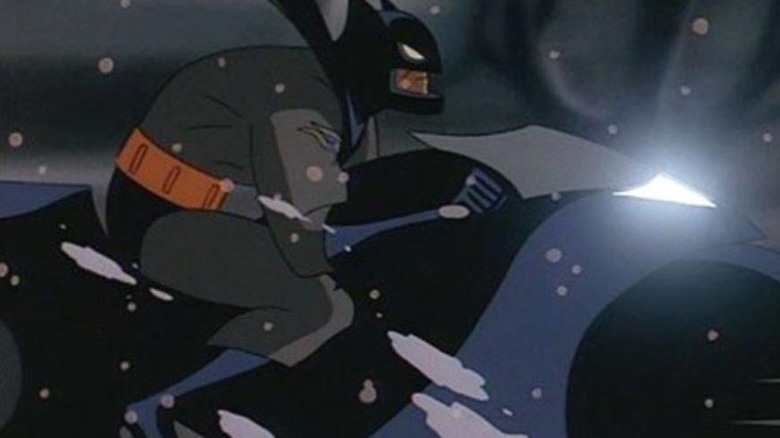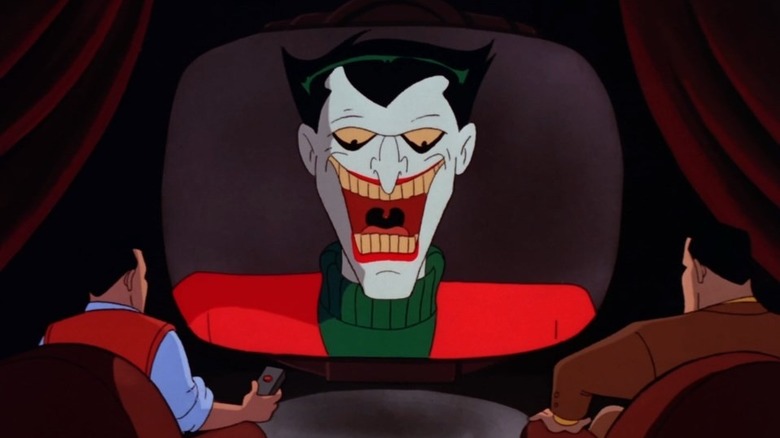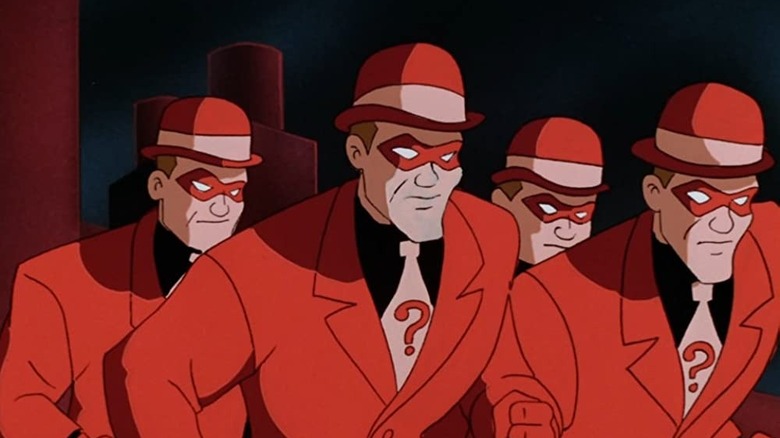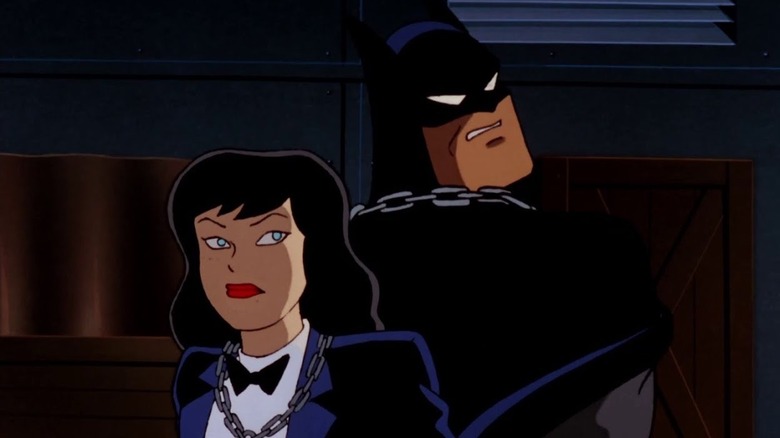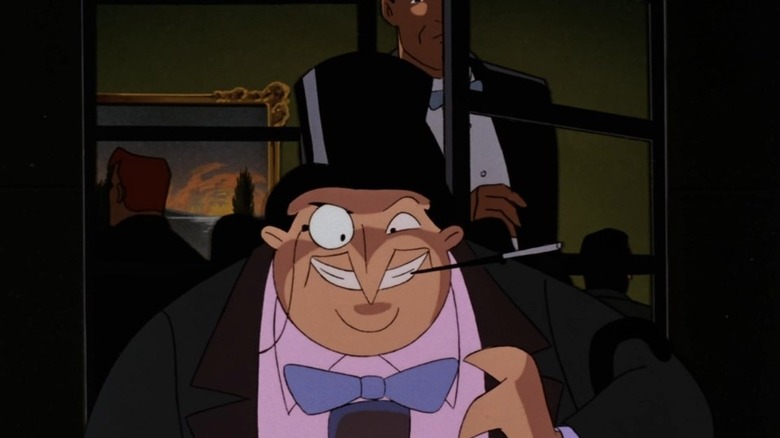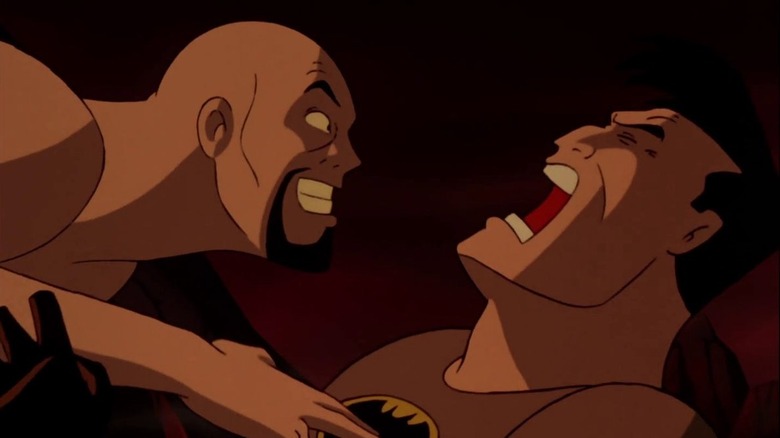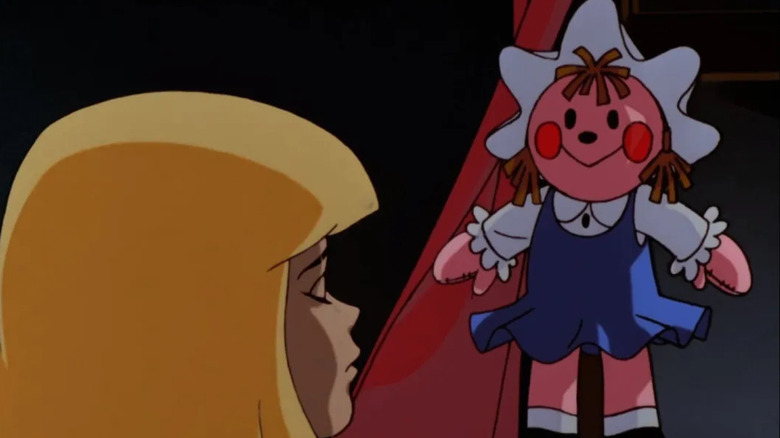12 Underrated Episodes Of Batman: The Animated Series
"Batman: The Animated Series" isn't just one of the greatest animated television shows of all time, but one of the most perfect comic book adaptations in history. While the saga of the Dark Knight has been told many times on the page and screen, "Batman: The Animated Series" explored the depths of Bruce Wayne's psyche. Many Bat-fans would argue that there isn't another actor who has captured the essence of the character quite like Kevin Conroy.
One of the best elements of "Batman: The Animated Series" was the show's emphasis on Gotham City's rogue's gallery. Mark Hamill brought chaotic energy to the Joker, which made Batman's arch-nemesis both hilarious and terrifying. Other villains like The Penguin (Paul Williams), The Riddler (John Glover), Two-Face (Richard Moll), Catwoman (Adrienne Barbeau), Poison Ivy (Diane Pershing), and Scarecrow (Henry Polic II) received terrific spotlight episodes and storylines. The creation of the character Harley Quinn (Arleen Sorkin) inspired subsequent comic book storylines, and led to Margot Robbie's acclaimed performance in the DCEU. Episodes like "Heart of Ice," "The Man Who Killed Batman," "Almost Got 'Im," "Two-Face," and "Trial" are often heralded as the best installments in the series. However, the series was so excellent for its entire run that there are hidden gems that deserve more attention. Here are 12 underrated episodes of "Batman: The Animated Series" that you need to check out.
On Leather Wings
Man-Bat, the villainous alter ego of Dr. Robert Kirkland Langstrom, is one of the most underrated antagonists in the DC universe. While Man-Bat has been a popular figure within "Detective Comics" since the 1970s, he sadly has yet to appear in any of the theatrical DC comic book adaptations. However, "Batman: The Animated Series" did a great job at fleshing out Man-Bat's origin story, and introducing such an unusual antagonist early on in the series signified that this show was unafraid to take stylistic risks.
"On Leather Wings" is a great example of Batman's detective abilities. He has to research Phoenix Pharmaceuticals and the Gotham Zoo to discover how Man-Bat's serum works. It's a remarkably well-paced episode that saves the major action sequences for the very end. This was an important precedent to set, as viewers realized that the show wasn't interested in replicating iconography from the comics if there wasn't a good story. The eventual reveal of Man-Bat in his monstrous form is utterly terrifying, imagery that feels closer to a Universal monster movie than anything from the "Batman" comics. Horror has always been an important part of the "Batman" universe, and "On Leather Wings" is one of the spookier installments of "Batman: The Animated Series."
Mad as a Hatter
One of the best attributes of "Batman: The Animated Series" was the show's ability to spotlight underutilized villains in the DC universe. The Mad Hatter wasn't particularly popular before "Batman: The Animated Series," giving the writers room to add their own interpretation. His debut appearance in "Mad as a Hatter" brought a memorable sense of theatricality to the series. Roddy McDowell's stellar vocal performance highlighted Jervis Tetch's feeling of self-hatred as he spirals into insanity.
Like many villains in the "Batman" canon, Tetch has a somewhat empathetic origin story, being hopelessly in love with his secretary Alice (Kimmy Robertson) though she ultimately rejects his advances. Instead of accepting Alice's decision, Tetch grows spiteful and vows to take vengeance on everyone that has spurned him. "Batman: The Animated Series" was keen to show that a lack of toxic masculinity is what differentiates Batman from the other costumed characters in Gotham City. The show also established Batman's code of personal ethics in "Mad as a Hatter" as he refuses to fight the people that are under the Mad Hatter's mind control knowing that they are unable to control their actions. These moral lessons are integral to his character.
Night of the Ninja
Since the series wasn't burdened with telling a two-hour story, it could take interesting stylistic departures for an episode or two. While many comic book television shows are simply trying to be movies, "Batman: The Animated Series" told interesting one-off stories that could only be shown on television. Did you ever want to see Batman placed in the middle of a Japanese action movie? Well, you're in luck! "Night of the Ninja" follows Kyodai Ken (Bob Ito), a ninja who breaks into Wayne Enterprises. After a brief battle, Batman realizes that this enigmatic ninja is his equal in combat. "Batman: The Animated Series" frequently showed flashes of Bruce's backstory, and "Night of the Ninja" tied into Bruce's training in Japan. It fleshed out his character arc by exploring how he earned his combat skills. It was also an interesting departure to see Bruce getting into adventures without the suit on.
"Night of the Ninja" also showed a more complex side to Batman's relationship with his young ward, the first Robin (Lorin Lester), who gets frustrated by Batman's secluded nature and feels that he is not being appreciated. This helped tease the future developments in their relationship in "Robin's Reckoning." The "Night of the Ninja" storyline was developed further in the subsequent episode "Day of the Samurai." It's clearly influential within the modern DC Animated Universe since the 2018 animated film "Batman Ninja" feels particularly indebted to the precedent that "Night of the Ninja" set.
Cat Scratch Fever
"Batman: The Animated Series" had to handle the expectations that came with introducing Catwoman. Given how iconic Michelle Pfeiffer's performance as Selina Kyle in "Batman Returns" was, it was going to be challenging to show a different side of the character. However, the show delved into the complexity of Catwoman's relationship with Batman where she's not quite willing to call herself his ally, but she doesn't cross the line into true villainy. "Cat Scratch Fever" offers a fun misadventure for Batman and Catwoman that features some of the show's most humorous moments.
Selina stands trial for all the crimes she has committed after her arrest in "The Cat and the Claw," almost as if the show was letting viewers decide if she should be given another chance. There are some amusing moments when Alfred (Efrem Zimbalist Jr.) teases Bruce about his attraction to Selina. This awkward tension continues when Catwoman is put in danger. She is given a more sympathetic storyline in this episode since she's just trying to save her cat. "Batman: The Animated Series" never failed to have terrific guest stars, and "Cat Scratch Fever" features a fun appearance by Ed Asner as the corrupt businessman Roland Daggett. Although the storyline featuring infected cats is a tad silly, the episode still has its serious moments when Bruce shows his genuine care for Selina. It was the perfect way to depict their relationship, where neither one wants to admit their feelings.
Moon of the Wolf
Horror is an important part of the "Batman" universe. Batman crafts his identity based on something that scared him as a child, and seeks to terrify the villains of Gotham City. What's something so spooky that it could even scare Batman? A werewolf! Although the mad scientist Professor Achilles Milo (Treat Williams) had previously appeared in "Cat Scratch Fever," he finds a new subject in "Moon of the Wolf" when he experiments on the aspiring sportsman Anthony Romulus (Harry Hamlin).
"Moon of the Wolf" explores how a lack of self-confidence can lead to unintended consequences. Even though Romulus is a skilled athlete in his own right, he seeks the help of Dr. Milo to guarantee that he will be victorious. Unfortunately for Romulus, Dr. Milo's serum transforms him into a werewolf, the design of which is inspired by classic Universal monster movies like "The Wolf Man" and "Werewolf of London." The scene where Romulus attacks Batman in the Gotham Coliseum is so scary that it's easy to forget that this show was intended for children! Once again, "Batman: The Animated Series" showed why Batman is so inventive: Even if he's no match for a werewolf in single combat, he knows that there's a way to outwit a mindless beast that has little control over his actions. "Moon of the Wolf" also shows the integrity that makes Batman so heroic since he knows what Romulus did was wrong, but he shouldn't have to suffer.
Terror in the Sky
"Terror in the Sky" continued the story of Man-Bat after the events of "On Leather Wings." "Batman: The Animated Series" did a great job at retaining its internal continuity. Actions had consequences, and it was interesting to see Batman following up on cases that he had seemingly solved. This showed the eternal struggle that Batman faced being unwilling to kill his enemies and thus bound to fight them over and over again.
In "Terror in the Sky," Kirk's wife Francine Langstrom (Meredith MacRae) is accidentally exposed to the same serum that cursed her husband, becoming a new villain known as "She-Bat." However, "Terror in the Sky" didn't feel like a retread of "On Leather Wings" because of the difference between Francine's and her husband's motivations. While Kirk had been trying to create a new species, Francine has no control over her powers, unable to remember her experiences as She-Bat. This sets up a sympathetic backstory that forced Batman to make tough ethical decisions. "Terror in the Sky" also shows a more sympathetic side to Kirk himself by fleshing out his relationship with Francine, casting Man-Bat's crimes in a different light. It's particularly heartbreaking to watch Francine blame Kirk for crimes that he did not commit because the audience knows that he has grown since the events of "On Leather Wings."
Christmas With The Joker
Mark Hamill's performance as The Joker stands as the definitive depiction of the character. Although Cesar Romero, Jack Nicholson, Heath Ledger, and Joaquin Phoenix are all iconic in their own way, Hamill captured the malevolent, chaotic spirit of The Joker like no one else. Although the episodes "Old Wounds," "The Laughing Fish," "Joker's Favor," and holiday season.
Hamill understood that The Joker thinks of himself as a comedian since all of his evil plots are simply elaborate pranks that he pulls to amuse himself. "Christmas With The Joker" gave Hamill the chance to show off his singing voice when The Joker sings demented renditions of holiday songs like "Deck The Halls." There's even a hilarious moment where he plays "Dance of the Sugar Plum Fairies" from "The Nutcracker Suite" when Batman and Robin are trapped in a factory. The Joker isn't the only funny character in this episode, as Robin gets some great lines due to a running gag about "It's A Wonderful Life." While Robin is intent on celebrating Christmas Eve by watching the classic holiday film, Batman admits that he's never seen it because he could "never get past the title." This adds a humorous tension between the two as Robin tries to make Batman's Christmas a little bit merrier.
What Is Reality?
Virtual reality was still a novel concept in the 1990s. In "What Is Reality?" The Riddler attempts to prove that he is smarter than Batman by forcing him to enter a digital trap in order to save the life of Commissioner Jim Gordon (Bob Hastings). The episode delved into The Riddler's motivation, wanting to prove his superior intelligence and see Batman confused by his traps. This is also The Riddler's greatest weakness because he can't help but give his enemies a way out if they are clever enough. Unfortunately for The Riddler, Batman usually is.
The introduction of a cyber attack was an interesting way for "Batman: The Animated Series" to tie into current issues. While the computer terminology from the 1990s hasn't aged particularly well, it makes enough sense in the warped version of reality that Gotham City resides in. The sequence where Batman enters The Riddler's maze is one of the most visually inventive moments in the entire series. It felt like the show was trekking into experimental territory with its bold colors and gravity-defying logic. "What Is Reality?" also underscores the importance of Batman's relationship with Gordon, who doesn't just provide Batman with assistance as he solves crimes, but gives him a moral center that prevents him from going too far. "What Is Reality?" shows that Batman is willing to risk life and limb in order to save his friend.
Zatanna
"Zatanna" marked the debut of a fan-favorite character who would subsequently appear in "The New Batman Adventures," "Batman Beyond," "Gotham Girls," and "Justice League: Unlimited." This episode found an exciting way to tie into Bruce Wayne's childhood when he was going by the pseudonym "John Smith," training with the stage magician Zatara ("Batman Returns" co-star Vincent Schiavelli) to learn the art of illusion. A young Bruce takes an interest in Zatara's daughter (Julie Brown) whom he is unable to forget about.
This was fun to show a flirtatious side of Bruce that we didn't generally see in "Batman: The Animated Series." Unlike Catwoman, Zatanna appears to have a lot of the same goals as Bruce. She has remarkable agency and claims she doesn't need Batman's help to clear her name for a crime she did not commit. This forces Batman into an awkward situation where Zatanna questions why he would take such extreme measures to guarantee her safety: Is Batman willing to admit that he truly cares about someone? The tragedy of Batman's romances is that they are all doomed from the beginning. Bruce fears attaching himself to someone else because he's afraid that they will be taken away from him, lending a bleakness to his charming encounters with Zatanna. They push each other's buttons in all the right ways, and they're both as competent in solving crimes. They seem like they would make a perfect couple, but it was never meant to be.
Birds of a Feather
The Penguin was never a particularly sympathetic character in the "Batman" comics. While characters like Mr. Freeze (Michael Ansara) and Poison Ivy (Diane Pershing) at least had tragic backstories, there wasn't anything relatable about a greedy businessman who wants to expand his wealth. However, "Birds of a Feather" showed a different side of The Penguin as he tries to escape his path of crime after being released from prison. It asks a deeply moral question: Are the most wicked people capable of redemption?
Even though The Penguin is grotesque and often rude, he is painted in a very sympathetic light in "Birds of a Feather." He begins to fall in love with the wealthy socialite Veronica Vreeland (Marilu Henner) after she invites him to a social engagement. The Penguin believes that her intentions are sincere, and has no idea that she is planning to deceive him with her kindness. Watching The Penguin slowly realize that he's the butt of a joke is quite tragic. Like Batman, he is really just a lonely child who has never felt that he has been accepted by society.
Day of the Samurai
"Day of the Samurai" provides an excellent conclusion to the story arc initiated in "Night of the Ninja." Since Kyodai Ken survived his encounter with Batman, he swears to take vengeance on his old nemesis. Ken is one of the few villains that are able to piece together Batman's secret identity and, given his knowledge of Bruce's past, he proves a serious threat.
Ken kidnaps the young martial arts trainee Kairi Tanaga (Julia Kato) and forces her to steal a mythical scroll that reveals the secrets of an ancient fighting technique. It's unfortunate that "Day of the Samurai" is Kairi's only appearance in "Batman: The Animated Series," because she's a compelling character who holds her own against Bruce. They've both trained to become martial arts experts, and Kairi is keen to show her skills. The ending of "Day of the Samurai" features one of the most incredible fight scenes in the entire series. Forced to fight without his mask for once, Bruce and Ken duke it out in an epic brawl outside a volcano. The fiery atmosphere provides an incredible backdrop for the sequence, easily one of the more brutal battles in a series that often pushed the boundaries of children's television.
See No Evil
Seeing children in danger tends to rub Batman the wrong way. Kids that are neglected or abused forces Bruce to think back about his own childhood and the loss of his parents, although he is well aware that he grew up with privileges that most families in Gotham City did not have. In "See No Evil," Batman is forced to become a personal savior to a child. It feels like he's not just saving her from evil, but saving her soul. Batman is there to give her hope that there's a better future ahead of her.
In a twist on H.G. Wells' classic story of "The Invisible Man," the convicted criminal Lloyd Ventrix (Michael Gross) steals a suit that renders him invisible. Ventrix isn't set up to be the next super-villain, he's simply trying to win back the affection of his young daughter Kimmy (Elisabeth Moss). It's actually quite terrifying to see how Ventrix plays upon his child's imagination. Instead of telling her the truth, he poses as a version of her imaginary friend, "Mojo." "See No Evil" takes a break from the epic battles with the main antagonists to tell a more intimate family drama, a nice change of pace for the series that proved that deep down Batman had a heart.
